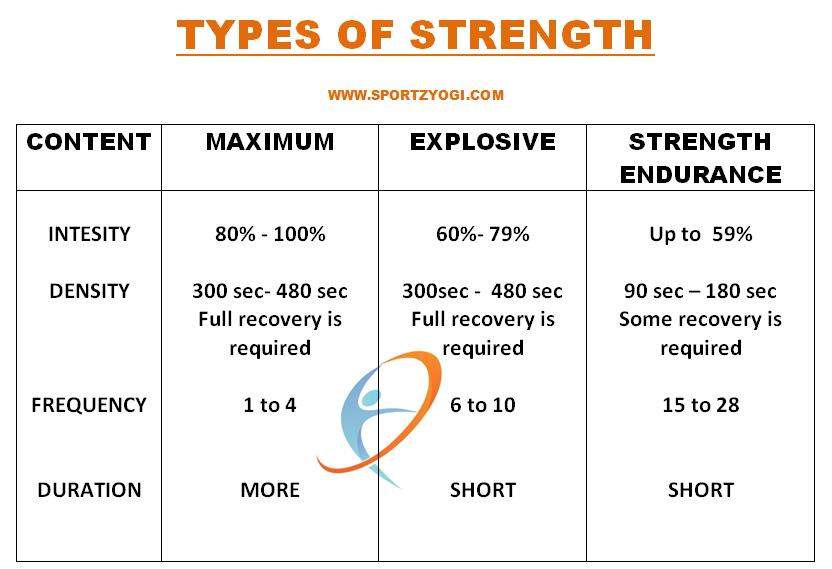What is strength and its types?
what is strength and its types:- Strength is the capability to overcome resistance or to act against resistance. Strength depends largely on the energy Liberation processes in the muscle. Strength is the most important motor ability in the field of sports as it is a direct product of muscle contraction. All Movement in sports is caused by muscle contraction. Sports training is generally done for General Health and a good physique. ‘’Zimmermann’’ has very rightly briefed the positive effect of strength training on the HEART, muscles, JOINTS, BONES, circulatory system, metabolism, and nervous system.
In Each sport, strength appears in a different form. Good warming up is necessary prior to any kind of strength training. The trainer should explain all the important precautions to be taken in prevent to prevent injuries. Basically, there are four types of resistance during strength training-: resistance of own body, the resistance of opponents, the resistance of equipment, and friction resistance.
Strength is a psycho-physical ability that defines performance and is created by muscle tension allowing overcoming relatively high resistance.
The strength ability can be divided into three types described below-:
- Maximum strength
- Explosive strength
- Strength endurance
MAXIMUM STRENGTH-
It is the ability to act or overcome maximal resistance. It is measured by finding out the maximum force that can be applied by the muscle, OR in other words the highest level of muscle force that can be produced, maximal strength is the capability of a muscle or specific group of muscles to recruit and engage all motor units to generate maximal tension against an external resistance. Which requires a high level of neuromuscular efficiency to enhance both intra- and intramuscular coordination, develop maximum strength, and less repetition with the intensity training
Example- powerlifting, [squat, bench press, and deadlift]
EXPLOSIVE STRENGTH–
It is a composite of SPEED and strength abilities. Explosive strength is the capability to overcome resistance with high SPEED, Generating of maximal amount of force in a minimal amount of time; muscle lightening followed by rapid acceleration through the shortening phase, Mainly devoted to the speed of movement through a ROM [RANGE OF MOTION]. In sports maximum number of movements is explosive in nature and involves overcoming some external resistance, to develop explosive strength, repetition should be performed as fast as possible with the sub maximum intensity.
Explosive subdivided into three parts
- Starting strength– It displays the maximum mass FORCE on any new movement and develops the maximal muscle FORCE. Or generate force at the starting of a movement without momentum or a pre-stretch to load mechanical energy, start moving from a stationary position. E.g. sprint start, weight lifting.
- Strength speed– This is the ability to cross the maximum resistance with high speed. E.g. throw jump.
- Speed strength– It has the ability to cross the lower resistance with high speed. Speed strength– the maximal force capable of being produced during a high-speed movement, trained with either bodyweight or a minimal amount of resistance, allowing the movement to be executed as fast as possible, for example- throwing a basketball, or sprinting.
STRENGTH ENDURANCE-
It is the ability to overcome resistance under the condition of fatigue. The ability to maintain muscular contraction or a consistent level of muscle force for extended periods of time, Relies upon the aerobic capability to provide oxygen and nutrients to the functioning muscles while removing metabolic waste, for Example- Games like judo, marathons, triathlon, basketball, etc.
Strength endurance is categorized into some parts;-
Static strength– It is the ability to act against resistance and is also called ISO-METRIC strength. Ex- push-up against the wall.
Dynamic strength– It is the ability to overcome resistance and is also called ISO-TONIC strength.
Relative strength– The amount of force generated per unit of body weight. Can be increased by using all of the various types of strength training to improve the magnitude of force production while maintaining or reducing total body mass and if the neuromuscular efficiency and muscle force production increase while maintaining a consistent body mass, relative strength will increase.
RATIO-: Maximum strength/body weight
FACTOR AFFECT STRENGTH
- Muscle size
Strength depends on the size of the muscle. The tension of the muscles is directly helpful in the formation of strength. The wider the mass of the muscle, the stronger it will be. The average internal area of the muscles can be increased from 5 to 12 kg / sq.m. There is no difference in the composition of the muscles of men and women. But men’s muscles are stronger than women’s muscles.
- Composition of muscles
Each muscle produces less stretch and more stretch of fibers. The fibers that pull quickly also shrink quickly. Masses that have rapid fibrous stretch are stronger. Usually, the stretch and contraction of fibers in muscles do not change through training.
- Coordination among Motor Units & Muscles
When the muscles contract, a lot of the motor units also contract simultaneously. If these motor units are stretched together, their strength will result that the units of the units will also be higher.
When new training is started, the muscles and the motor units maintain correlation.
- The intensity of nerve impulses
Muscles are the structure of motor units. The ultimate strength of the muscles depends on the contraction of the motor units. Not all motor units are likely to shrink at will. It is driven only in crisis or by electricity.
- Energy supply factor
The sources of energy supplied during muscle contraction should be very good. Muscles should get a sufficient amount of energy according to their requirement. The main source is an energy source in the body is ATP. In which the amount of energy supply is less, its strong performance will be poorer, so the maximum rate and amount of energy supply are required to overcome the strength performance or high-speed resistance training.
- Training factor
Training is an important factor in developing strength and endurance in any sport for the physical challenge. If you don’t continue to work the muscle on a regular basis, you may lose the strength you built. Returning to a sport or physical activity after an extended absence, you may notice that you feel weak and tired much sooner. Typically, with a little preservation, you can regain that strength.
- Bodyweight
It has also been proven scientifically and it is believed that heavier humans are more powerful than small humans. This is known to us when we look at the records of those who carry weights. A heavier man will lift more weight.
READ MORE ABOUT= physical fitness





